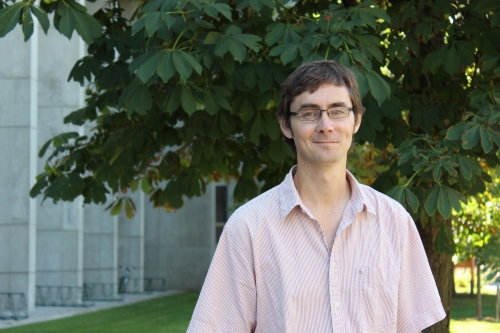WATERLOO, Ont (Wednesday, August 28, 2013) – A team of mathematicians has solved a problem first posed more than 40 years ago that has confounded modern mathematicians, until now.
Professor Jim Geelen of the University of Waterloo and his colleagues, Professor Bert Gerards of Centrum Wiskunde & Informatica and the University of Maastricht in the Netherlands, and Professor Geoff Whittle of Victoria University of Wellington in New Zealand have proved the famous Rota’s Conjecture.
The three men worked for almost 15 years to solve this problem posed by the famous mathematician and philosopher Gian-Carlo Rota in 1970. Earlier this year, in Waterloo, the trio completed the final step in their epic project.
Rota’s Conjecture relates to a specialized area of mathematics known as matroid theory, a modern form of geometry, which was pioneered by the world-famous, Waterloo-based mathematician Bill Tutte.
The theory investigates the embedding of abstract geometric structures, or matroids, into concrete geometric frameworks – namely, projective geometries over a given finite field. The conjecture is that, for each finite field, there is a finite set of obstructions preventing such a realization. The conjecture was posed by Rota at the International Congress of Mathematics in 1970, serendipitously, one week before Geelen was born.
"For me the most rewarding part of the research project has been the collaboration with Bert and Geoff. We work together about three times a year typically for periods of three weeks either here in Waterloo or in New Zealand or the Netherlands,” said Professor Geelen. “Those visits are intense; we sit in a room together, all day every day, in front of a whiteboard. The discussion can be very lively at times, while at other times, when we are stuck, we might sit there for two hours without saying a word; each just thinking about ways to overcome the particular obstacle.”
In 1999, Geelen, Gerards and Whittle joined forces to work on Rota’s Conjecture as well as generalizing the famous Graph Minor Theory developed by Robertson and Seymour to matroids.
Last year they completed their Matroid Minor Theory which gives deep insights into the structure of matroids. The proof of Rota’s Conjecture relies on the full power of that theory and, in addition, required groundbreaking new results on matroid connectivity.
According to the trio, the real hard work only just began when early this year they started writing up the results of their work. The Graph Minors Theory itself filled more than 600 journal pages and the Matroid Minors Theory is set to be at least as long. The team expects that it will take them at least three years to complete the writing.
Jim Geelen is a Professor in the Department of Combinatorics and Optimization at the University of Waterloo and holds a Canada Research Chair. He has received several prestigious honours including a Fulkerson Prize, a Sloan Fellowship,and the Coxeter-James Prize.
About the University of Waterloo
In just half a century, the University of Waterloo, located at the heart of Canada's technology hub, has become one of Canada's leading comprehensive universities with 35,000 full- and part-time students in undergraduate and graduate programs. Waterloo, as home to the world's largest post-secondary co-operative education program, embraces its connections to the world and encourages enterprising partnerships in learning, research and discovery. In the next decade, the university is committed to building a better future for Canada and the world by championing innovation and collaboration to create solutions relevant to the needs of today and tomorrow. For more information about Waterloo, please visit www.uwaterloo.ca















